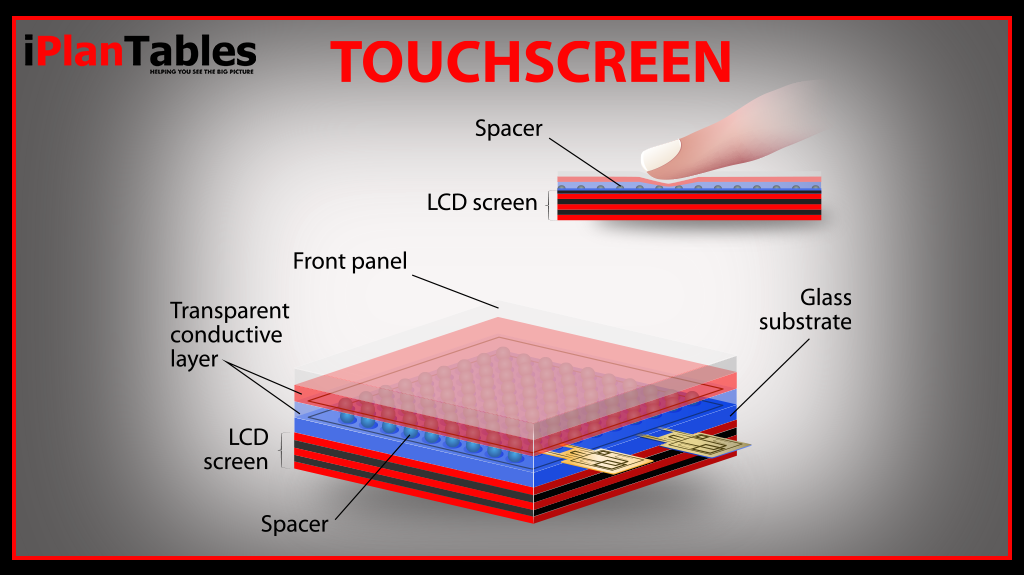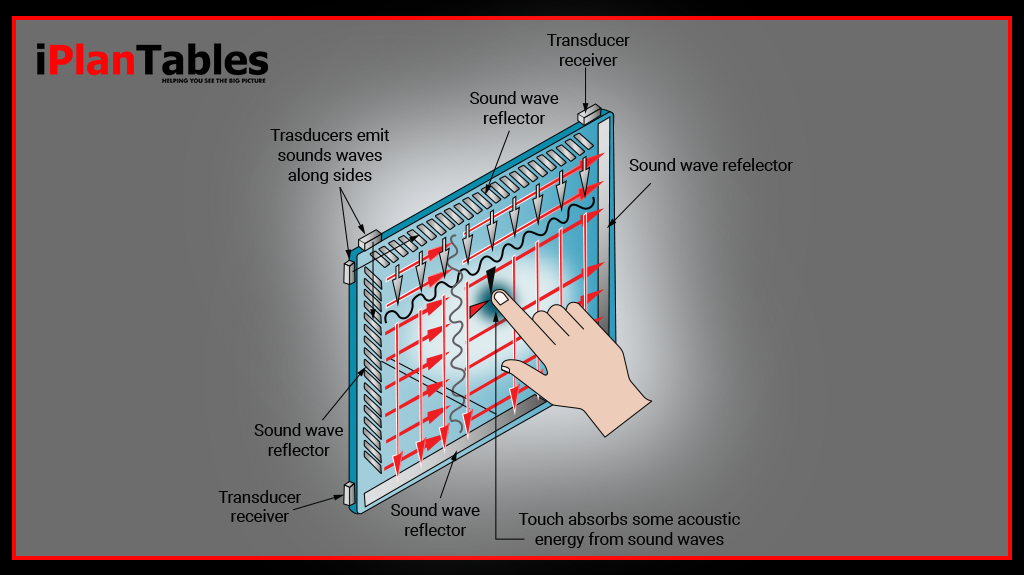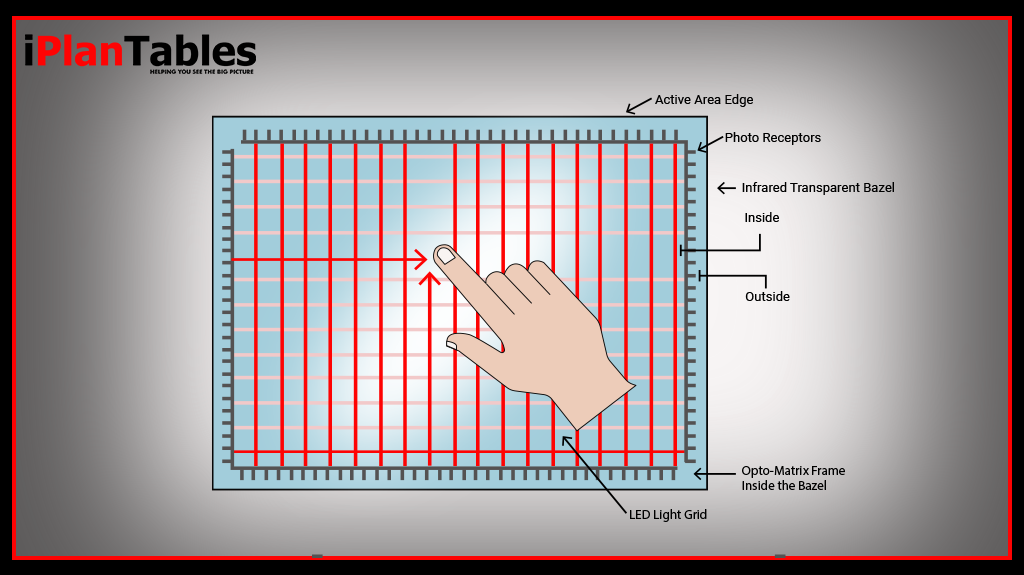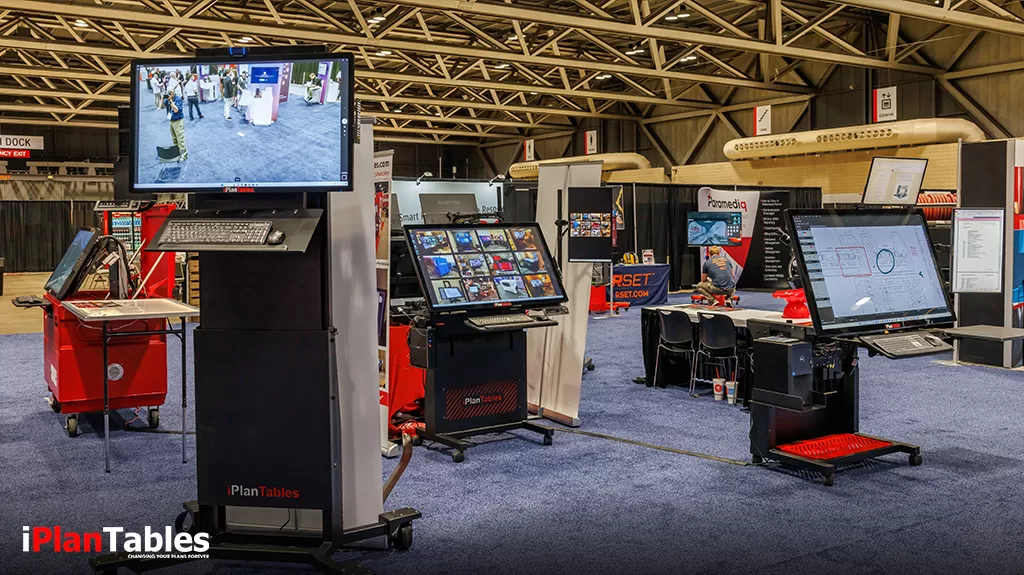Touchscreen technology has come a long way in recent years, and several types are available on the market. There are four main types of touch screen technology: resistive, surface acoustic wave, infrared, and capacitive. We’ll discuss the first three types and why iPlanTables workstations use the fourth – projected capacitive.
Here is how the different types of touchscreen technology work:

Types of touch screen technology – Introduction to Resistive Touch Screen Technology
Resistive touch screens are the simplest and oldest types. A resistive touch screen comprises a glass panel and a plastic film, which are separated by air or inert gas.
Resistive touch panels are made of two layers of conducting material separated by a small space. When pressure is applied to the top layer, the two layers make contact, and a voltage — electrical current– is generated and flows between them. This voltage is used to determine the X and Y coordinates of the touch. This change in pressure is registered as an input, and the device responds accordingly. Resistive touch panels are durable and can be used with a stylus or finger. However, they are not as sensitive as other types of touch panels and can be affected by dust and scratches.
One of the main advantages of resistive touch screens is that they can be used with any object, including a finger, stylus, or glove.
The major drawback of resistive touch panels is that they’re less durable than their competitor and don’t provide multi-touch functionality. They also rely on single-point contacts, which makes them unable to function correctly in many instances where styluses are required. An example of a resistive touch screen is at grocery stores, where you use a stylus to provide a signature confirmation after credit card purchases. Resistive touch screens are less responsive than other touch screens and can be less accurate.
What is Surface Acoustic Wave Touch Screen Technology?

Surface acoustic wave touch screens are included in the types of touch screen technology listing, and it has a thin layer of transparent material on the surface. When a finger or other object touches the surface, the waves are disturbed, and the X and Y coordinates of the touch are determined. Surface acoustic wave touch panels are very sensitive and can be used with bare fingers or gloves. They are also durable and resistant to water and other liquids. However, they are more expensive than other types of touch panels.
Surface acoustic wave touch screens also have piezoelectric transducers that generate ultrasonic waves. When your finger touches the screen, it distorts the waves, and this change is registered as an input.
Surface acoustic wave touch screens are less common than other types of touch screens.
Understanding Infrared Touch Screen Technology
Infrared touch screens are also a category included in the types of touch screen technology and are the most expensive type of touch screen technology. They comprise an array of infrared light-emitting diodes (LEDs) and photodetectors placed around the screen’s edges.

When an object, such as a finger, touches the screen, it interrupts the infrared beams of light, which are then registered as an input — the X and Y coordinates of the touch are determined. The device responds accordingly.
Infrared touch panels are very sensitive and can be used with bare fingers or gloves. They are also durable and resistant to water and other liquids. However, they are more expensive than other touch panels and are not as responsive as other types of touch screens.
Infrared touch panels create a grid of infrared beams across your screen and detect contact via disruption. This type can detect multiple touches at once while remaining durable enough for outdoor use. However, you should take care if placing them in direct sunlight because, unlike other types, it won’t work well.
iPlanTables Favorite — Projected Capacitive PCAP
iPlanTables workstations use Projected Capacitive touch screen technology for all our workstation models. Although the screens come in various sizes — 43 inches to 75 inches — the type of touchscreen technology is the same across all of them.
Projected Capacitive touch screen technology is one of the most advanced and accurate touch screen technology available today. It’s used in a wide range of applications, from smartphones to industrial machines. And it’s the perfect choice for our iPlanTables workstations.

Projected Capacitive touch screens comprise a matrix of rows and columns of tiny conductive elements. When an electrical current is applied, an electrostatic field is created. When your finger or another conductive object (such as a stylus) touches the screen, it disrupts the field, and the touchscreen can determine the location of the touch.
This type of touch screen is extremely accurate and responsive, making it ideal for use in our workstations. It also has excellent durability and can withstand repeated use. So, if you’re looking for a high-quality, durable, and accurate touch screen for your workstation, look no further than iPlanTables Projected Capacitive touch screen technology.
Now that you know about the different types of touch screen technology, you can see why iPlanTables builds our workstations with PCAP large touch screen monitors.
Contact us today for more information.
Follow us on Facebook

